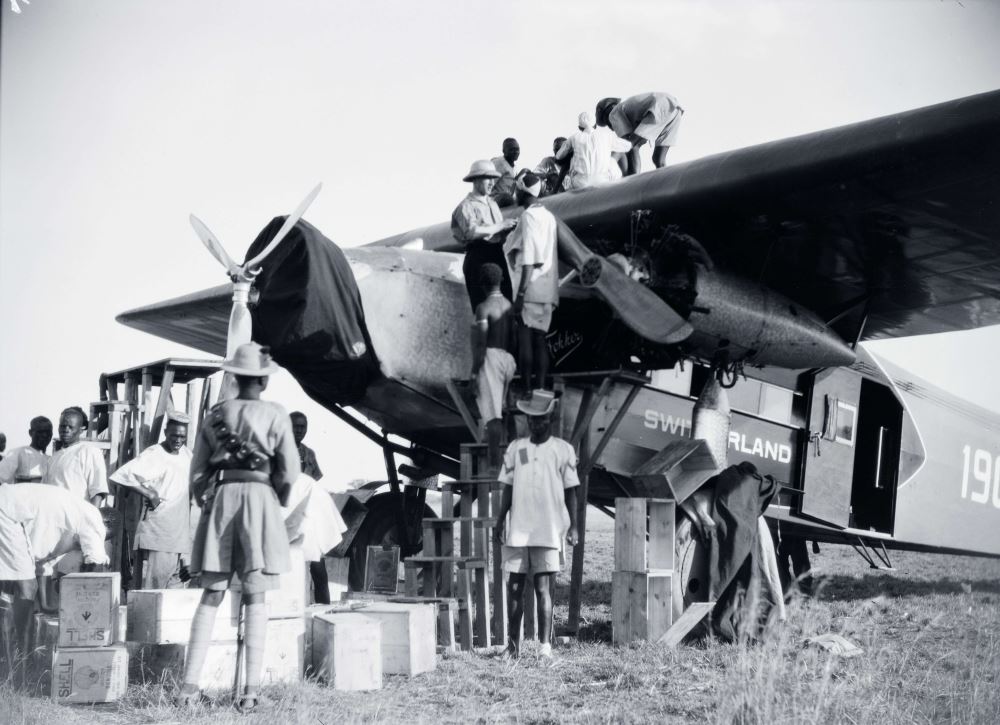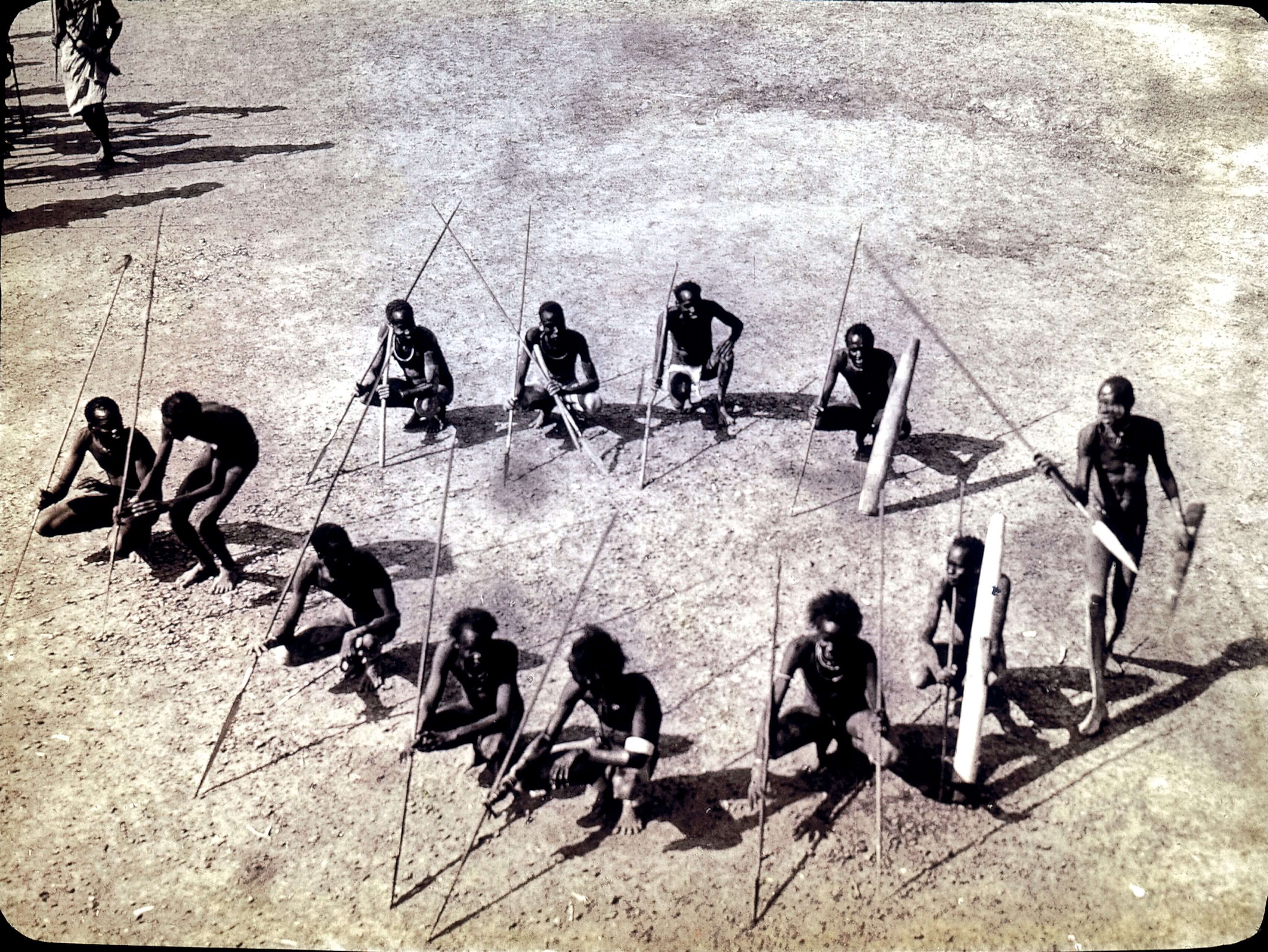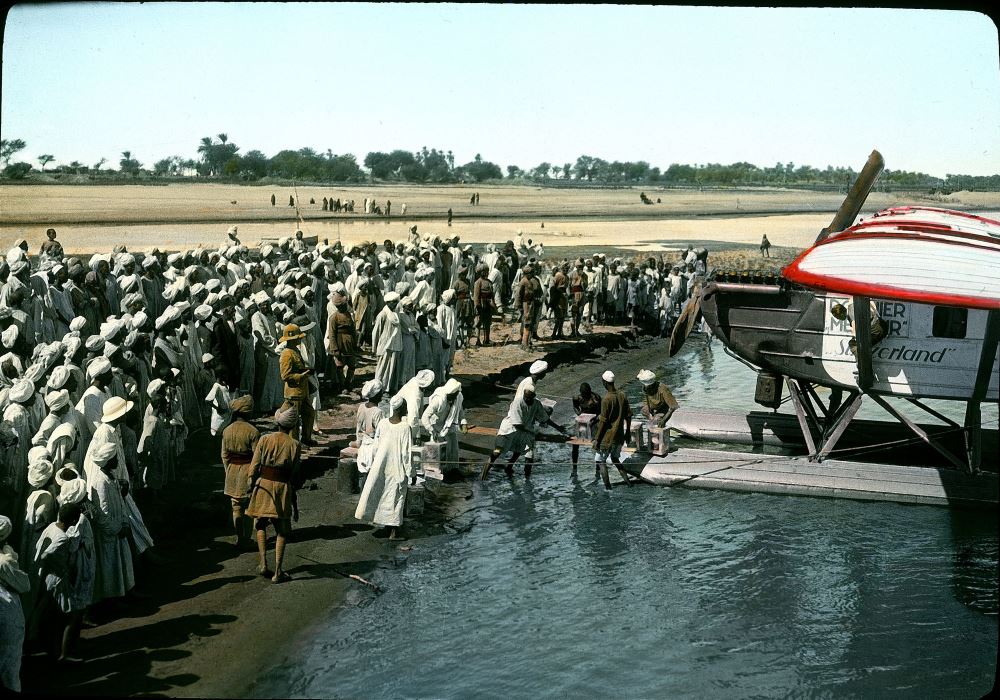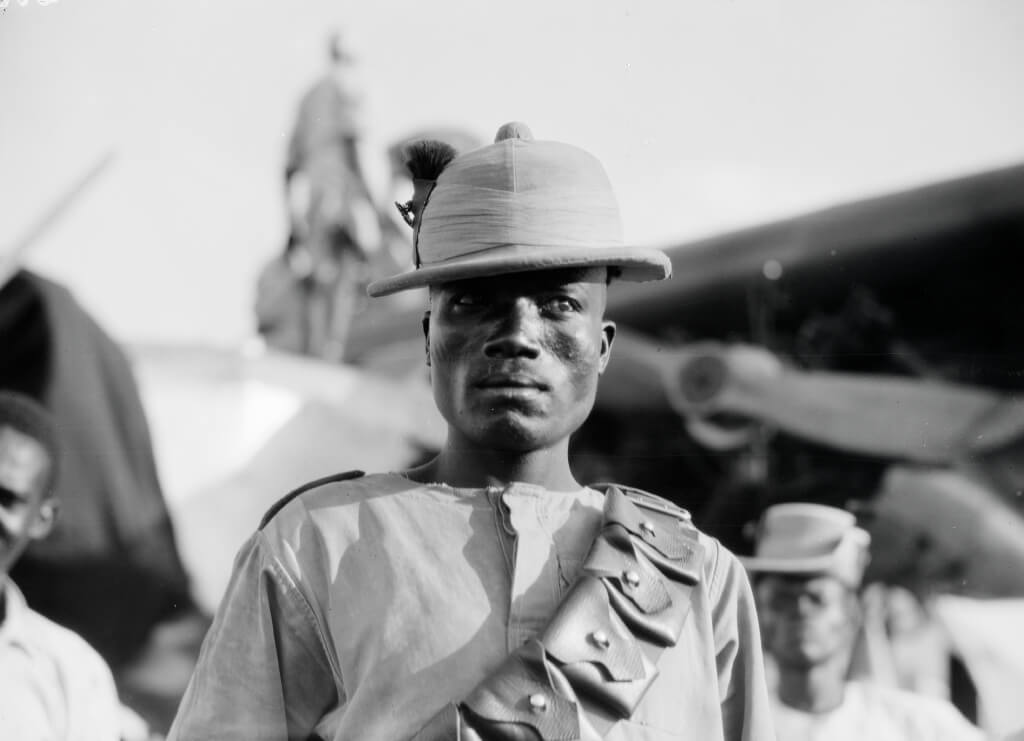 Tanken in Mongalla bei 40° hitze (Refueling in Mongalla in 40° heat [3 January 1930]), Kilimanjaroflug (Kilimanjaro flight), 1929-30 | LBS_MH02-07-0129, ETH-Bibliothek Zürich, photo archive
Tanken in Mongalla bei 40° hitze (Refueling in Mongalla in 40° heat [3 January 1930]), Kilimanjaroflug (Kilimanjaro flight), 1929-30 | LBS_MH02-07-0129, ETH-Bibliothek Zürich, photo archive
The ETH-Bibliothek's collection contains about 18,000 photographs taken by Walter Mittelholzer (1894 – 1937) and Albert Heim (1849 – 1937) between 1924 and 1934. Many were taken in Sudan and South Sudan. Of particular interest are photographs from Mittelholzer's trans-African flight (1926-27), Kilimanjaro flight (1929-30), Lake Chad flight (1930-31), Abyssinia flight (1934), and Nord Africa flight (1932). ETH-Bibliothek's Mittelholzer collection is in the public domain.
In 1919, Mittelholzer and his flight instructor, Alfred Comte, co-founded an air-photo and tourist-flight business, Gesellschaft Comte, Mittelholzer und Co., Luftbildverlagsanstalt und Passagierflüge, Zürich, which became Swissair after merging with Ad Astra Aero in 1920 and Balair in 1931. In the winter of 1926-27, Mittelholzer flew from Zürich to Cape Town in a Dornier Mercury seaplane, which was named "Switzerland" and equipped with a darkroom. In addition to his mechanic and co-pilot, Hans Hartmann, Mittelholzer was accompanied by two men who went along to lend the trip some gravity by making scientific observations, René Gouzy, an "authority on African life and customs," and Dr. Albert Heim, a geologist.
The trip was mainly staged as a media event, and Mittelholzer's regular dispatches to the Swiss press made the men famous. "[M]any times have science and sport marched hand in hand towards unhoped-for success," Albert Heim wrote in 1927.1 But there was a contradiction between ethnography and record-breaking. The one usually demands lengthy studies on the ground, the other is mainly a matter of speed and quick departures. (In some ways this contradiction prefigures "the fly-in-fly-out journalism and the hit-and-run rapid rural appraisals of NGOs" that research in South Sudan is at risk of becoming.2)
Mittelholzer developed what Oliver Lugon calls an "aeronautic-ethnographic image," in which "crowd scenes or group portraits were taken at a steep angle from the raised aircraft cabin after the plan itself had already landed. These strange framings produced views that came close to fulfillinng the rules of ethnographic photography, but were sufficiently elevated to remind the observer of the aeronautic aspect of Mittelholzer's art."3
 The "aeronautic-ethnographic image": Episode aus dem Tanz. Man beachte die schmalen Schildhölzer rechts, Abwong, 1927 Kilimanjaroflug (trans-African flight, 1926-27) | ETH-Bibliothek Zürich, photo archive
The "aeronautic-ethnographic image": Episode aus dem Tanz. Man beachte die schmalen Schildhölzer rechts, Abwong, 1927 Kilimanjaroflug (trans-African flight, 1926-27) | ETH-Bibliothek Zürich, photo archive
Mittelholzer modeled himself after the fashion of earlier colonial figures. After splashing down on Table Bay at the Port of Cape Town, he emerged from the "Switzerland" dressed in a khaki shirt, shorts and stockings and set about filming the crowd that had gathered there to meet him. Stories of trans-continental flight enjoyed a wide audience in Europe. Technological expertise was held out as an argument to justify colonial rule, and Mittelholzer's photographs are often of colonial subjects gathered around and gawping at aeroplanes, as if by doing so they could be seen to consent to colonial oppression by acknowledging the superiority of technological things.
 Wasserflugzeug nahe am Festland, umgeben von Menschen (caption: Seaplane near the mainland, surrounded by people), 30 December 1926 (trans-African flight, 1926-27) | ETH-Bibliothek Zürich, photo archive
Wasserflugzeug nahe am Festland, umgeben von Menschen (caption: Seaplane near the mainland, surrounded by people), 30 December 1926 (trans-African flight, 1926-27) | ETH-Bibliothek Zürich, photo archive
"Although, on the surface, there was nothing spectacular about this flight," the editors of Flight wrote in 1927, "it has been, nevertheless, a splendid performance."4 The flight made Mittelholzer famous and attracted the attention of Baron Louis von Rothschild who, in 1929, engaged Mittelholzer to fly him to Nairobi for a hunting expedition, which paid for Mittelholzer's flight over Kilimanjaro.
Comte, Mittelholzer und Co. played an important role in the development of air tourism. Over the next years,the company merged with a pair of Swiss aviation companies, Ad Astra Aero and Balair, and, in addition to regular passenger and air-mail services, "did a considerable amount of touring, taxing, and joy riding work" for thrill-seekers and tourists.5 Mittelholzer's regular dispatches to the Swiss press, cinema, radio, and theatre talks, popular books of aerial photography, and record-setting flights (1st to fly over the Matterhorn, 1st over Kilimanjaro, &c.6 ) helped to keep Swiss aviation in the international press, providing excitement for readers and assurances of the safety of more routine flying. By 1931, Nestlé and Anglo-Swiss Condensed Milk Co. (today known, simply, as Nestlé) had even produced a board-game for children to follow Mittelholzer route from Zürich to Cape Town.
 Mit Mittelholzer durch ganz Afrika | Avec Mittelholzer par avion à travers l'Afrique (Switzerland, 1931) | source |
Mit Mittelholzer durch ganz Afrika | Avec Mittelholzer par avion à travers l'Afrique (Switzerland, 1931) | source |
There seems to have been a mix-up at the Nestlé & Anglo-Swiss Condensed Milk Co. Image No. 9, "Danse de guerriers Kavirondo au bord du lac Victoria" (Dance of Kavirondo Warriors on Lake Victoria) is clearly based on a photograph taken by Arnold Heim in 1927 at Abwong on the Sobat and titled, in the ETH Zürich collection, "Episode aus dem Tanz. Man beachte die schmalen Schildhölzer rechts" (see above).
The ETH-Bibliothek's collection of Mittelholzer's trans-African (1926-27) and Kilimanjaro flight (1929-30) contains many old-fashioned ethnographic images of Sudan and South Sudan: "types" (of dress, of people), group portraits and dancing scenes, village scenes, and panoramas of exotic landscapes.
 Soldat bei Betankung der Fokker (Mongala, 3 January 1930), Kilimanjaroflug (Kilimanjaro flight), 1929-30 | LBS_MH02-07-0206, ETH-Bibliothek Zürich, photo archive
Soldat bei Betankung der Fokker (Mongala, 3 January 1930), Kilimanjaroflug (Kilimanjaro flight), 1929-30 | LBS_MH02-07-0206, ETH-Bibliothek Zürich, photo archive
Footnotes
1 Albert Heim, ‘Preface’, In Walter Mittelholzer, René Gouzy, Arnold Heim, R-A-S-T. En hydravion de Zurich au Cap de Bonne-Espérance: le raid aérien suisse-transafricain (Neuchâtel: Ed. de la Baconnière, 1927), 10.
2 Doughlas H. Johnson, A new history for a new nation: the search for South Sudan's usable past (Keynote, 9th International South Sudan and Sudan Studies Conference, Bonn, 23-25 July 2012), 4.
3 Oliver Lugon, 'The Aviator and the Photographer: the case of Walter Mittelholzer,' In Seeing from Above: the aerial view in visual culture, Mark Dorrian, Frédéric Poussin, eds. (London: I.B. Tauris, 2013), 159.
4 The Swiss-African Flight, Flight, 3 March 1927, p. 118
5 One Year's Air Traffic in Switzerland, Flight, 14 February 1930, p. 213
6 His "firsts" mostly involved flying over mountains.
See also
Aviation & colonial racism
Chandra D. Bhimull, Empire in the Air: Speed, Perception, and Airline Travel in the Atlantic World (PhD dissertation, The University of Michigan, 2007)
Patricia Purtschert (2016) Aviation skills, manly adventures and imperial tears: the Dhaulagiri expedition and Switzerland's techno-colonialism, National Identities 18, no.1 (2016), 53-69
Photography
Kate Addleman-Frankel, The Experience of Elsewhere: Photography in the Travelogues of Pierre Trémaux, photographies 11, no. 1 (2018), 31-56,
David Campbel, Geopolitics and visuality: Sighting the Darfur conflict, Political Geography 26, no. 4 (2007), 357-382
Yotam Gidron, “One People, One Struggle”: Anya-Nya propaganda and the Israeli Mossad in Southern Sudan, 1969–1971, Journal of Eastern African Studies (2018)
James C. Faris, Leni Riefenstahl and the Nuba peoples of Kordofan province, Sudan, Historical Journal of Film, Radio and Television 13, no. 1 (1993), 95-97
Paul Fox, Kodaking a Just War: Photography, Architecture and the Language of Damage in the Egyptian Sudan, 1884–1898, In Clarke J., Horne J. (eds), Militarized Cultural Encounters in the Long Nineteenth Century. War, Culture and Society, 1750-1850 (Palgrave Macmillan, 2018)
Jane Hogan and Martin W. Daly, Images of Empire: Photographic Sources for the British in the Sudan (Brill, 2005)
John Hutnyk, Comparative Anthropology and Evans-Pritchard's Nuer Photography, Critique of Anthropology 10, no. 1 (1990), 81-102
Christopher Morton, Double alienation: Evans-Pritchard’s Zande and Nuer photographs in comparative perspective , In Richard Vokes (ed.), Photography in Africa: Ethnographic Perspectives (Woodbridge: James Currey, )
Christopher Morton, The Initiation of Kamanga: Visuality and Textuality in Evans-Pritchard’s Zande Ethnography, In Christopher Morton and Elizabeth Edwards (eds.), Photography, Anthropology and History: Expanding the Frame (Farnham: Ashgate, 2009)
Christopher Morton, Fieldwork and the Participant-Photographer: E. E. Evans-Pritchard and the Nuer rite of gorot, Visual Anthropology 22, no. 4 (2009), 252-74